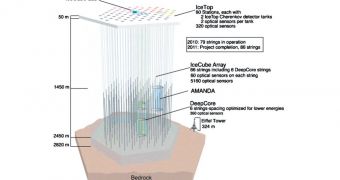Neutrino telescopes were first proposed as far back as the 1950s, but it was not until late last year that one of these instruments, buried deep under Antarctic ices, was able to make the first verified observations of these elusive elementary particles.
The findings have since spurred a renewed interest in this field, with several more detectors planned for construction over the next few years.
Neutrino astronomy is a very complicated field of astronomy, which deals with studying these minute, zero-charge elementary particles in order to reveal their origins, and thus gain a deeper understanding of high-energy phenomena in the Universe. But neutrinos do not readily interact with normal matter.
This is largely due to their extremely high speeds and near-zero mass, as well as to the fact that they are largely immune to the effects of gravity. Astrophysicists believe that these particles are produced by cosmic rays, as they interact with their surroundings after being released during supernovae and other energetic events.
The IceCube Neutrino Observatory in Antarctica was the first to detect signs of neutrinos passing through our planet, in November 2013. “We now have the opportunity to determine what the sources are, if we are indeed seeing sources of cosmic rays,” says physicist Francis Halzen.
The expert holds an appointment as a theoretical physicist with the University of Wisconsin-Madison, and is also the principal investigator for the IceCube effort. The detector lies under the Amundsen-Scott South Pole Station, and fills a volume of one cubic kilometer (0.24 cubic miles).
“The big difference why it's new astronomy is that we are not using light, we are using neutrinos to look at the sky,” Halzen goes on to say. He adds that neutrinos can be produced by black holes, supernovae, cosmic rays and the active nuclei of very distant galaxies, Space reports.
Previous experiments were able to detect neutrinos released by the Sun, and from SN 1987A, a supernova that exploded in 1986. IceCube last year found the first-ever neutrinos that were released from distant cosmic sources.
The research “is the point in time when it becomes real,” comments University of Erlangen-Nuremberg physicist Uli Katz, who works for the planned KM3NeT neutrino telescope in the Mediterranean Sea.
“Each time we find another way to make a picture of the sky – using gamma rays, X-rays, radio waves – you have always been able to see things you never saw before,” he goes on to say. When completed, KM3NeT will span 5 cubic kilometers (1.2 miles).
Another telescope currently in the works is the Gigaton Volume Detector (GVD), which is to be assembled by Russian scientists on the foundation of the existing Baikal Neutrino Telescope, in Lake Baikal. This landscape feature is the largest freshwater lake by volume in the world.

 14 DAY TRIAL //
14 DAY TRIAL //